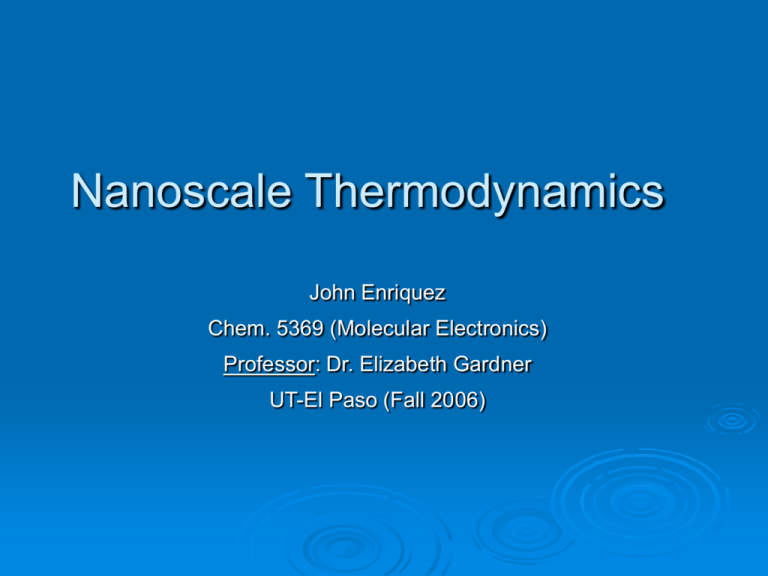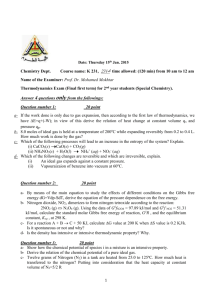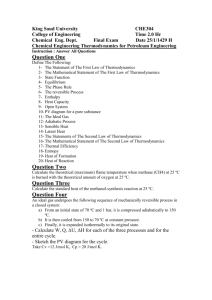Nano-scale Thermodynamics
advertisement

Nanoscale Thermodynamics John Enriquez Chem. 5369 (Molecular Electronics) Professor: Dr. Elizabeth Gardner UT-El Paso (Fall 2006) Brief Overview What is nano-thermodynamics and where did it begin? Who is the first person to research this topic? How is it being used today? Physical data and thermodynamic properties regarding selected compounds found in many nanoHUB presentations. Compounds Found in Molecular Electronic Articles While viewing selected presentations on the nanoHUB website, the same organic compounds are used in almost every SAM procedure. Also, one metallic solid is used. They are: Dodecanethiol, Ethanol, Tetrahydrofuran (THF), Ammonium Hydroxide, and Gold. What is Nano-Thermodynamics? First, thermodynamics is the investigation of changes in energy coming from a physical or chemical reaction. Gibbs Free Energy G = H – T(S) The thermodynamic variables of enthalpy (H), entropy (S), and free energy (G) are used in the Gibbs free energy equation. What is Nanothermodynamics? Nano-thermodynamics studies these same changes. The two differences are chemical potential and an ensemble term. G = H – T(S) + [Σ(μ·dn)] + (E·dN) Nanothermodynamics connects nanosystems to macroscale thermodynamics What is Nano-thermodynamics? The chemical potential term, [Σ(μ·dn)] was added by Gibbs in 1961 The symbols μ is the chemical potential and n is the amount in moles. Hill included the nano-thermodynamics term which is added at the ensemble level of the system, [E·dN]. The variable E is similar to a system’s chemical potential. The variable N is the number of individual systems in that one solution component. • An ensemble of N equivalent and noninteracting small systems is itself a macroscopic system. What is Nano-thermodynamics? Usefull in analyzing both experimental and theoretical equilibrium properties of nanosystems Ex. Mean field cluster model of ferromagnetism (ref.6) For a thorough treatment of the theory and derivations of the equation, see reference 4. When did this idea begin? The idea and the study of small systems at equilibrium can be traced back to Terrell L. Hill. From 1961 to 1963, Hill researched these small systems in great detail. Without being aware of it, he was researching ways to connect macro-thermodynamic systems to nanothermodynamic systems. He published his results in 1962 and 1963, but little attention was given to it since it was based on theoretical and statistical models. Nanoscience was not yet discovered. New attention for an old topic? In recent years, research in nanoscience has caught up with Hill’s theoretical work. In 2000, R.V. Chamberlin, who was investigating ferromagnetism, was one of the first scientist to use nanothermodynamic theory to explain his findings. Hill reexamined nanothermodynamics as a useful tool for nano-systems at equilibrium. Nanothermodynamics Today Professor Hill’s theories have been published in “Thermodynamics of Small Systems.” (Ref. 8) R. Chamberlin was instrumental in reviving interest in small system thermodynamics. In 2005, A link was established between Hill’s nanothermodynamics and Tsallis (nonextensive) thermodynamics. (Ref. 10) Nanothermodynamics Today Since this area is still new, few articles about this subject are available. Nanothermodynamics has the potential to be an important contributor to nanoscience and technology Physical Data & Thermodynamic Properties of Common Compounds Used in Nanoscience Dodecanethiol (C12H26S) Ethanol (CH3-CH2-OH) M.W.: 202.4 g/mol M.W.: 46.07 g/mol M.P.: unknown M.P.: -114.1 °C at 760 mmHg B.P.: 143.5 °C at 15 mmHg B.P.: 78.2 °C at 760 mmHg Density: 0.8435 g/cm3 at 20 °C Density: 0.7893 g/cm3 at 20 °C Solubility: Soluble in ethanol, ethyl ether and chloroform. Insoluble in water. Solubility: Miscible in water, ethanol, ethyl ether and acetone. Enthalpy (H) = -253.3 kJ/mol Enthalpy (H) = -277.6 kJ/mol Entropy (S) = 689.9 J/mol·K Entropy (S) = 160.7 J/mol·K Gibbs (G) = 78.01 kJ/mol Gibbs (G) = -174.8 kJ/mol Physical Data & Thermodynamic Properties, Cont. Tetrahydrofuran (THF): C4H8O Ammonium Hydroxide: NH4OH M.W.: 72.11 g/mol M.W.: 35.05 g/mol M.P.: -108.3 °C at 760 mmHg M.P.: -77 °C B.P.: 65 °C at 760 mmHg B.P.: 36 °C Density: 0.8892 g/cm3at 20 °C Density: Approx. 0.9 g/mL Solubility: Soluble in water. Very soluble in ethanol, ethyl ether and acetone. Solution Conc.: 14.8 mol/L Enthalpy (H) = -216.2 kJ/mol Entropy (S) = 204.3 J/mol·K Gibbs (G) = Physical Data & Thermodynamic Properties, Cont. Gold (Element Symbol: Au) Atomic Number: 79 M.W.: 196.96 g/mol M.P.: 1064.18 °C B.P.: 2856 °C Specific Gravity: 19.3 at 20 °C Solubility: Aqua Regia H (Fusion): 12.7 kJ/mol H (Vaporization): 343.1kJ/mol Reference: CRC Handbook of Chemistry & Physics, 2001-2002 Helgeson, H.C.; Owen, C.E.; Knox, A.M.; Richard, L. Geochim. Cosmochim. Acta, 1998, 62, 6, 985 References 1. CRC Handbook of Chemistry & Physics, 2001-2002 2. Helgeson, H.C.; Owen, C.E.; Knox, A.M.; Richard, L. Geochim. Cosmochim. Acta, 1998, 62, 6, 985 3. Hill, T.L. J. Chem. Phys. 1962, 36, 3182 4. Hill, T.L. Nano Letters, 2001, 1, 273 5. Hill, T.L. Nano Letters, 2001, 1, 111 6. Hill, T.L. Nano Letters, 2001, 1, 159 7. Hill, T.L.; Chamberlin, R.V. Proc. Natl. Acad. Sci. U.S.A. 1998, 95, 12779 8. Hill, T.L. Thermodynamics of Small Systems; Dover: New York, 1994 9. Chamberlin, R.V. Nature 2000, 408, 337 10. Garcia-Morales, V., Cervera, J., & Pellicer, J. Physics Letter A, 2005, 336, 82 Acknowledgements Dr. Elizabeth Gardner Dr. Michael I. Davis My fellow classmates in Dr. Gardner’s Molecular Electronics course at UTEP, UTEl Paso.








